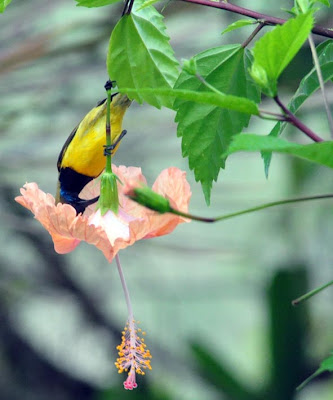Dillenia suffruticosa (Simpoh air in Malay) is an interesting plant. It is usually found growing wild on open slopes and spread by root runners. I pulled one of the suckers out from the wild and have it planted in the garden.
The flower The new leaf is copper-coloured and emerge from a slit in the older leaf.

This new leaf has a lovely sheen like polished copper. Older leaves were once used as a food wrapper.
8.11.12: A newly formed raceme bearing flower buds

Allamanda violaceas are seen in the background.

After a shower, water droplets dripped down the buds. The curved raceme with the flower buds lined up like grapes.

The flower in profile.

At end of the day, all five petals dropped on to the large leaf below.

What was left were the five sepals of the first flower.

It looks like another flower.
The second flower bloomed two days later. The first fruiting was aborted as can be seen from the bare stalk of the first flower.

The bud of the 3rd flower is ready to pop anytime.
In fact the 3rd flower bloomed the next day.
Ants came at dawn to partake of the sweet offerings.
Now its the turn of the 4th flower to be in anthesis.
The appearance of the 5th flower.
Outcome of a successful pollination - A fruit.
Of the cluster of nine flowers, eventually it was the seventh flower which bore fruit.
26.12.12: The fruit dehisced to reveal six segments of seeds covered with red pulp. Birds love them. Fruits face upwards. To photograph it I have to turn it sideways.
At the end of the day, it look rather shriveled up. Here I noticed another fruit, produced from the 8th flower. So, the final tally - 8 flowers and 2 fruits.

In the evening a dragonfly perched on its stem

Now its the turn of the 4th flower to be in anthesis.
Petals of the 4th flower dropped by dusk. The ants have not finished their business of gathering. There is no winter in the tropics, so the ants should learn to have some fun like the grasshopper.
The appearance of the 5th flower.
Outcome of a successful pollination - A fruit.
Of the cluster of nine flowers, eventually it was the seventh flower which bore fruit.
26.12.12: The fruit dehisced to reveal six segments of seeds covered with red pulp. Birds love them. Fruits face upwards. To photograph it I have to turn it sideways.

In the evening a dragonfly perched on its stem

A really good camouflage. The body looked similiar to the stem in colouring.

















































